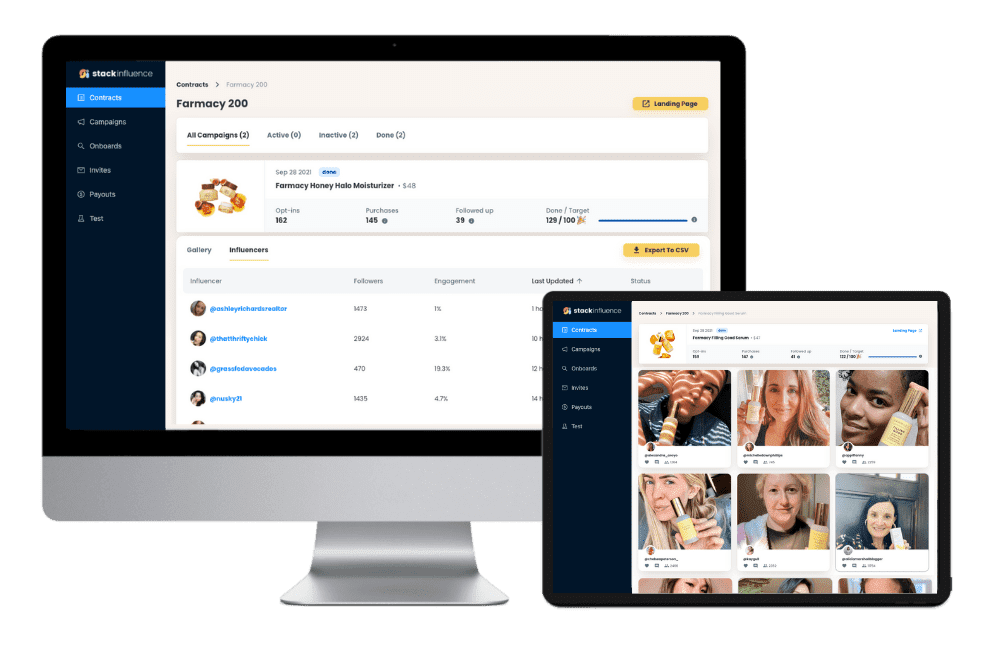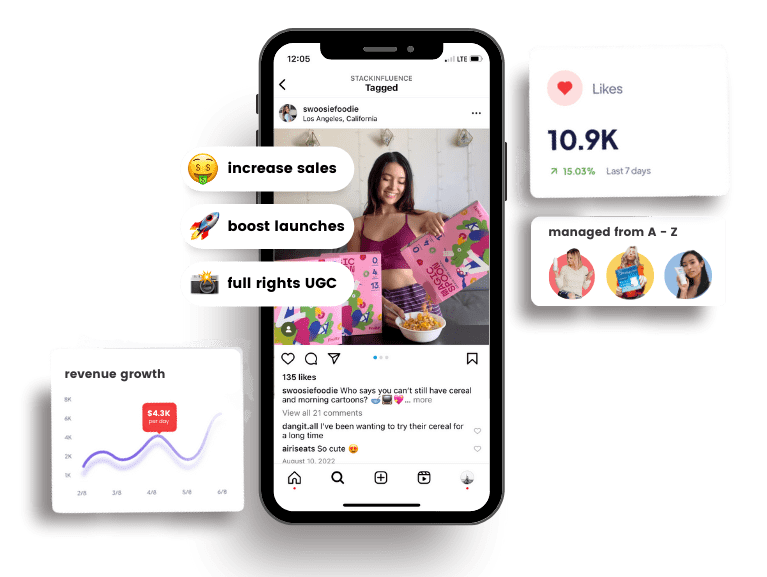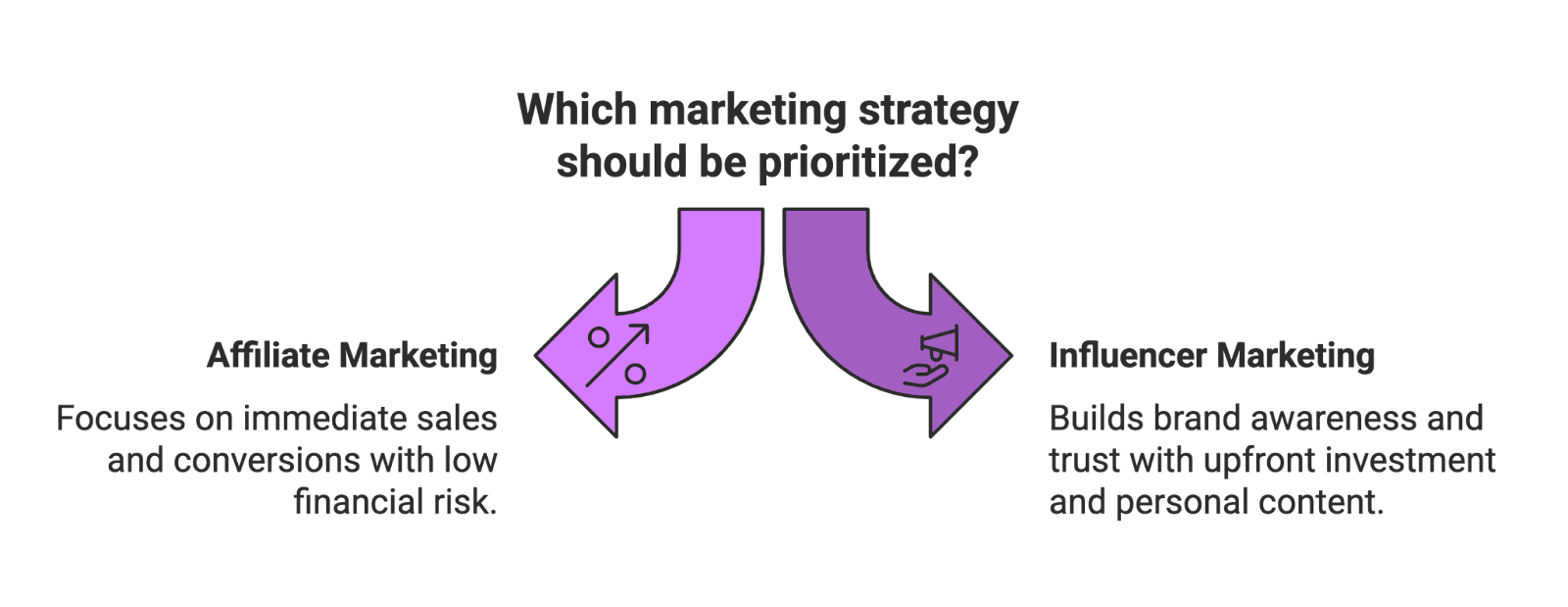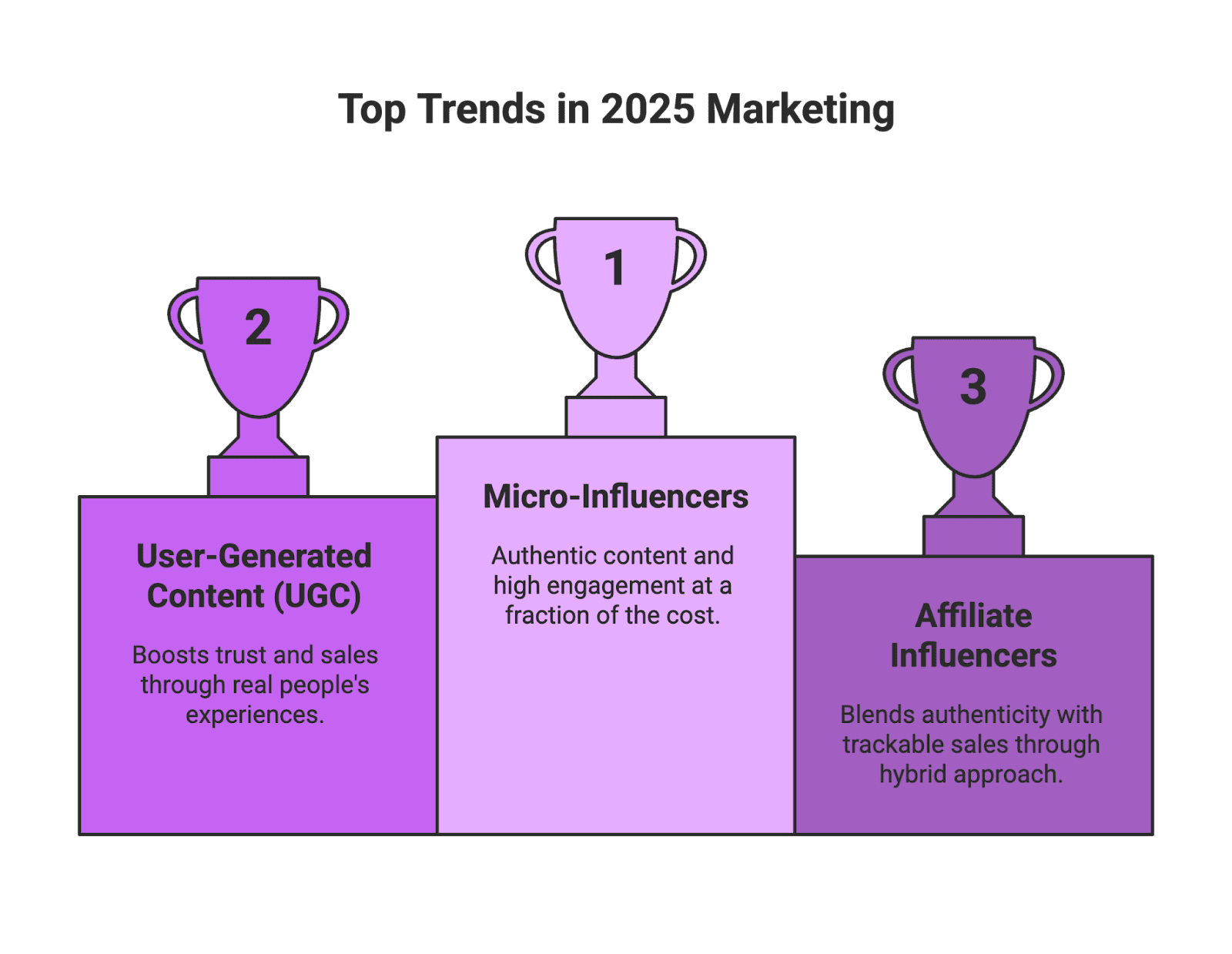Affiliate vs. Influencer Marketing in 2025
3rd
August, 2025
Influencer Marketing
Amazon Marketplace
Artificial Intelligence
TikTok Tips
In 2025, e-commerce businesses and marketers have more options than ever to promote their products. Two of the most powerful digital strategies are affiliate marketing and influencer marketing – but they work in different ways. Understanding the strengths of each (and how they overlap) is key to maximizing ROI. In simple terms, affiliate marketing is a performance-based channel where partners earn commissions for driving sales, while influencer marketing focuses on partnering with content creators to boost brand awareness and trust. Both approaches have evolved significantly, with trends like micro-influencers, user-generated content (UGC), and even AI shaping how brands leverage these tactics. This article breaks down affiliate vs. influencer marketing in 2025, their differences, where they converge, and how e-commerce brands (from independent sellers to Amazon marketplace vendors) can use both effectively. Let’s dive in!
What is Affiliate Marketing in 2025?
Affiliate marketing is a pay-for-performance strategy where businesses reward external partners (affiliates) for bringing in customers or sales. These affiliates can be bloggers, comparison sites, coupon portals, or even influencers who share a unique referral link or code. Whenever someone clicks that link or uses the code and makes a purchase, the affiliate earns a commission. This model means you only pay for results, making it a low-risk, conversion-focused approach. For example, Amazon’s Associates program (one of the world’s largest affiliate networks) lets content creators earn when they refer sales on Amazon – a huge benefit for Amazon sellers seeking more visibility. In fact, Amazon Associates holds nearly 46.5% of the global affiliate network share, highlighting how dominant it is in e-commerce affiliate marketing.
Affiliate marketing in 2025 continues to grow as a core sales driver for online businesses. It’s forecasted to reach about $12 billion in global value by 2025, accounting for roughly 16% of all e-commerce sales. Over 90% of e-commerce businesses are expected to adopt affiliate programs by 2026, making it nearly ubiquitous in the online retail space. The reason? Affiliates bring social proof and trusted recommendations from their audiences. Shoppers today are skeptical of traditional ads and instead look for authentic content and reviews. A well-run affiliate program taps into this by partnering with content creators whose values align with the brand and who have credibility with the target audience. Essentially, affiliates act as extensions of your marketing team, creating content (blog posts, videos, social media mentions) that subtly promote your product and drive traffic to your site or listing.
Pros of affiliate marketing: It’s cost-effective and low risk – you pay commissions only on actual sales or leads. This performance-based model ensures a positive ROI by design. Affiliate campaigns can also scale quickly by recruiting many partners, extending your reach to new audiences. Importantly for small businesses, affiliate marketing doesn’t require huge upfront spend; even a lean budget can attract affiliates if the product and commission are attractive. Also, affiliate efforts often generate evergreen content (like review articles) that keep driving traffic long-term.
Challenges: On the flip side, managing an affiliate program in 2025 means handling tracking and attribution in a privacy-conscious world (with cookies on the decline). Brands must use reliable referral link technology or coupon codes to attribute sales to affiliates, especially as ad blockers and privacy regulations can complicate tracking. Additionally, maintaining quality is key – not every affiliate’s content is high-quality, so vetting partners is crucial to ensure they align with your brand and don’t engage in spammy tactics. Despite these challenges, affiliate marketing remains a critical channel for e-commerce growth because it’s scalable, measurable, and aligns cost with performance.
What is Influencer Marketing?
Influencer marketing involves partnering with content creators (influencers) who have an engaged following on social platforms to promote your products. Typically, brands provide free product samples, pay a flat fee per post, or offer other incentives to the influencer, who in turn creates content (a post, story, video, etc.) showcasing the product. The goal is to leverage the influencer’s reach and trust with their audience to build your brand awareness, rather than to drive immediate sales (though sales often follow). In essence, influencer marketing pays for exposure and credibility – you’re investing in the influencer’s ability to sway their followers.
Influencer marketing has exploded into a multi-billion dollar industry. By the end of 2025, the global influencer marketing market is projected to reach $32.5 billion, up from just $1.4B a decade earlier. Over 80% of marketers now consider influencer campaigns highly effective, and about 63.8% of brands plan to partner with influencers in 2025. The rise of platforms like Instagram, YouTube, and TikTok has made it easier for everyday people to become influential creators in specific niches – from beauty and fashion to tech and gaming. These content creators produce authentic, relatable content that audiences often find more credible than traditional ads. For example, an influencer might post a video using a kitchen gadget in a recipe, casually showing how it works. Followers see the product in a real-life context, which builds trust and interest in a way a banner ad can’t.
A big trend in 2025 is the dominance of micro-influencers and nano-influencers (creators with anywhere from a few thousand up to ~100K followers). While mega-celebrities have huge reach, brands are increasingly turning to smaller creators for stronger engagement and authenticity. Micro-influencers often have a tight-knit audience who trust their recommendations deeply. They might not reach millions, but their followers are more likely to act on their suggestions. Plus, micros are more cost-effective; many will collaborate in exchange for free products or modest fees, and some even work on an affiliate basis (hybrid model). Influencer marketing isn’t limited to Instagram selfies anymore – it spans TikTok challenges, YouTube reviews, livestream shopping events, podcasts, and more. And it’s not just for flashy consumer products; even traditionally “boring” industries like insurance and B2B have found creative ways to use influencers for education and brand lift.
Pros of influencer marketing: It’s superb for brand building and social proof. Influencers excel at creating engaging content that doesn’t feel like an ad, helping new or unknown brands get on consumers’ radar. A single viral post from the right influencer can dramatically boost traffic and sales overnight. Influencer content also doubles as UGC – brands can reshare it, adding authenticity to their own channels. Another benefit: influencers can produce a stream of creative assets (photos, videos, reviews) that the brand might never have the time or ingenuity to make in-house. This is particularly valuable for Amazon sellers or small e-commerce brands that need lifestyle photos or demo videos of their product – partnering with influencers essentially outsources content creation to talented creators. Furthermore, ongoing influencer partnerships can foster a sense of community and loyalty around your brand, as the influencer’s audience starts to form a relationship with your product over time.
Challenges: The biggest challenge with influencer marketing is measuring ROI and attribution. Unlike affiliate links that directly tie a click to a sale, an influencer’s impact can be more indirect and long-term. If an influencer’s Instagram post leads a follower to Google your brand a week later and then purchase, it’s hard to track that path. Thus, marketers sometimes struggle to quantify results beyond metrics like reach and engagement. However, savvy brands in 2025 are mitigating this by providing influencers with affiliate links or discount codes to capture sales data, essentially blending the two strategies. Another challenge is finding the right influencers and ensuring they align with your brand values. An influencer who doesn’t genuinely like or understand your product can come off as inauthentic, which audiences will sense. Lastly, managing multiple influencer relationships and campaigns can be time-consuming – negotiating rates, guiding content, ensuring posts go live on schedule – but new tools and platforms are emerging to streamline this process.

Unlock the Power of Micro Influencers and Elevate your Brand Today!

Affiliate vs. Influencer Marketing: 6 Key Differences

While these strategies often overlap, affiliate and influencer marketing have distinct strengths. Here are six key differences between them:
1. Primary Objective
Affiliate marketing is transactional – its main goal is to drive immediate sales or conversions. Influencer marketing is more relational, aiming to build brand awareness, trust, and credibility that can lead to sales down the line.
2. Payment Structure
In affiliate programs, compensation is commission-based – affiliates only get paid when their promotion results in a sale (or desired action). This could be a percentage of the sale or a flat bounty per conversion. In influencer marketing, payment is usually up-front (e.g. a fixed fee per post or free products), not contingent on immediate sales. Some influencers also get performance bonuses or commissions, but generally, brands pay for the content exposure regardless of outcome.
3. Financial Risk
Affiliate marketing presents low risk to the brand – if the affiliate doesn’t generate results, you don’t spend much (perhaps just some setup or management cost). Influencer marketing requires a higher upfront investment, so there’s a risk if a campaign doesn’t resonate. You’re essentially betting on the influencer’s content to be effective, and paying them even if sales don’t materialize immediately.
4. Content & Authenticity
Affiliate content varies widely. Some affiliates are review websites with fairly dry comparison content; others are passionate bloggers or YouTubers whose content is engaging. Influencer content is typically more personal and authentic, since it’s coming from an individual sharing their own experience. Followers often perceive influencer posts as recommendations from a friend, especially when the creator’s style is genuine. This doesn’t mean affiliate content lacks authenticity – in fact, many influencers are affiliates – but pure influencer marketing puts authenticity at the forefront.
In summary, affiliate = pay for outcomes, influencer = pay for influence. One is about immediate conversions, the other about cultivating brand love that drives conversions over time. Neither is “better” universally – they serve different purposes. Your choice depends on priorities: Do you need sales now, or is building brand equity and awareness more critical? Let’s explore how to choose.
When to Use Affiliate Marketing vs. Influencer Marketing
Both strategies can yield great results, but the right choice depends on your goals and situation. Here are some guidelines:
1. Influencer creates content.
This could be an Instagram post, a TikTok video, etc., featuring your product or brand message (as agreed upon in your collaboration). Make sure it feels authentic and aligns with the influencer’s usual style – authenticity is key here.
2. Influencer grants the brand advertising access.
This is the “whitelisting” step: the creator formally authorizes your brand to run ads using their identity or post. (How this is done varies by platform – we’ll explain Facebook/Instagram, TikTok, etc. shortly.)
3. Brand sets up the ad using the influencer’s handle/content.
In the ad platform (Facebook Ads Manager, TikTok Ads, etc.), you’ll create a campaign as usual – but select the influencer’s page or post as the source. You can adjust targeting, duration, and add a CTA link (e.g. to your online store or Amazon page). Pro tip: treat this like any paid ad – use conversion tracking and define your goals (traffic, sales, etc.).
4. Both the brand and influencer can monitor results.
The brand can see full performance metrics in the ad dashboard. The influencer typically can see basic insights too (and certainly will notice new followers or engagement coming their way). A whitelisted campaign often results in the influencer gaining new followers while the brand gains new customers – a win-win outcome.
Keep in mind, this isn’t an either/or choice for many brands. The most successful e-commerce companies use both, in complementary ways. For instance, a new Amazon seller might send free product to a group of micro-influencers to spark initial buzz (influencer marketing), and simultaneously enroll in an affiliate network so that bloggers and deal sites can promote their Amazon listing for commission (affiliate marketing). One strategy builds demand, the other captures it with conversion-focused channels. The next section looks at how these strategies can be integrated.

Unlock the Power of Micro Influencers and Elevate your Brand Today!

Micro-Influencers, Content Creators and UGC in 2025

One of the biggest trends in 2025 is the rise of micro-influencers and the emphasis on user-generated content (UGC) in marketing. Micro-influencers (often defined as creators with ~5,000 to 100,000 followers) have become a sweet spot for many brands. Why? They offer the best of both worlds: authentic content and high engagement, at a fraction of the cost of big influencers. In fact, many brands are shifting budgets toward micro and even nano-influencers in search of stronger engagement and ROI. These smaller creators typically have very loyal, niche audiences. When they post about a product, it comes off as a genuine recommendation from a peer, not a celebrity endorsement.
Moreover, micro-influencers often double as affiliates or content creators in their own right. They might run a YouTube channel or blog where they use affiliate links for extra income. For example, a micro-influencer on Instagram might share a fashion try-on video featuring a boutique clothing brand, and include an affiliate link in their bio or swipe-up story. In doing so, they’re acting as an “affiliate influencer,” blending authenticity with trackable sales. Most successful creators nowadays operate with this hybrid approach, adjusting their methods based on the partnership. They might do some purely sponsored content for a flat fee, and other content where they use affiliate links to earn commissions – it’s all about diversifying revenue for the creator, and it benefits brands by driving both awareness and conversions.
UGC is a goldmine generated by these collaborations. User-generated content refers to any content about your brand created by real people (not the brand itself). Influencer posts, customer reviews, unboxing videos, tagged photos – all of these are UGC. In 2025, UGC has proven to significantly boost trust and sales. For instance, shoppers who engage with UGC experience on average a 28% higher conversion rate than those who don’t. This is because seeing real people (whether influencers or everyday consumers) using a product provides social proof that heavily influences purchase decisions. Many e-commerce brands now actively encourage UGC – some run hashtags for customers to share photos, others repurpose influencer content in ads or on product pages. Amazon itself features influencer-created videos and photos on product listings through its Amazon Influencer Program, blurring the line between influencer marketing and traditional reviews.
To harness this, companies are leveraging platforms and agencies that specialize in micro-influencer campaigns. (Enter Stack Influence!) Stack Influence is one example of a micro-influencer marketing platform geared toward Amazon and e-commerce sellers. According to G2, Stack Influence focuses on the Amazon marketplace and uses a network of vetted micro-influencers (powered by AI tools) to run campaigns that generate tons of UGC and traffic for online sellers. Such services handle everything from sourcing influencers, managing the campaign, ensuring posts go live, to delivering the content rights and analytics. The beauty of micro-influencer campaigns is that often the only “payment” needed is free product – many micro-influencers are happy to receive a product gift in exchange for posting, which greatly minimizes cash outlay. This is particularly attractive to smaller Amazon vendors who might not have large marketing budgets; they effectively pay with product and still get the benefits of word-of-mouth marketing. The result is authentic UGC at scale – photos, testimonials, demonstration videos – that not only drive immediate sales from the influencer’s audience but can also be repurposed on the brand’s site, social media, or ads. It’s like fueling your marketing with a constant stream of real-life endorsements.
In summary, 2025’s focus on micro-creators and UGC means even modest-sized brands can punch above their weight. A handful of happy customers or micro-influencers posting about your product can snowball into a social proof engine. If you’re an e-commerce marketer, nurturing a community of micro-influencers and encouraging customers to share content should be a top priority. Not only do micro-influencers often have higher engagement rates (nano-influencers on TikTok, for example, see far higher engagement than mega accounts), but their content feels real. And real is what converts. As one report put it: the age of mega-influencers isn’t over, but brands are increasingly backing micro- and nano-influencers for more authentic content and stronger conversions. The trust these creators build translates directly into sales, especially when combined with the measurable tactics of affiliate links and referral codes.
Combining Affiliate and Influencer Strategies
It’s not a question of affiliate versus influencer marketing so much as how to use both together. In fact, the lines between the two have increasingly converged. Influencer marketing used to be strictly an upper-funnel tactic (create buzz, hope it leads to sales later), and affiliate marketing a lower-funnel tactic (drive the final purchase decision). But in 2025, that distinction is fading: “Affiliates can also generate awareness, and influencers can drive sales” as one expert noted. The real power comes when you combine these strategies to engage consumers at every point in the funnel.
Here are some ways to integrate affiliate and influencer marketing for maximum impact:
-
Give influencers affiliate links or discount codes:
This turns influencer campaigns into measurable, performance-driven efforts. When you partner with an influencer, provide them a unique promo code (for a percentage off) or an affiliate link to include in their content. This way, any sales they generate can be tracked back to them, marrying the reach of influencer content with the accountability of affiliate marketing. Many creators appreciate this because it gives them an ongoing income stream if their content keeps driving sales. Brands like to see direct ROI from influencer collaborations – a win-win. It’s common now for “influencer affiliates” to earn both an upfront fee and commissions on sales.
-
Leverage content creators as affiliates:
Think beyond the traditional coupon sites and bloggers; your influencers are also content-creating affiliates. For example, a tech YouTuber might be in your affiliate program, earning commissions from product review videos, while also being someone you sponsor for new product launches. Treat your best content creators like partners. Provide them with early access to products, exclusive deals, or higher commission tiers to incentivize them. Since 31% of content creators consider affiliate marketing a top revenue stream, many will be enthusiastic to join your affiliate program if the product fits their niche.
-
Use tools to manage combined campaigns:
Tracking performance across both strategies is crucial. Affiliate platforms (for tracking links and payouts) and influencer relationship tools should work hand in hand. For instance, some marketing platforms (like Sprout Social’s influencer solution or others) allow you to manage influencer outreach and content approvals, while integrating with your affiliate tracking system. This lets you monitor engagement metrics and conversion metrics in one place. By analyzing data collectively, you might discover that, say, an influencer’s TikTok video drove a lot of awareness, and a week later your affiliates saw a spike in conversions for that product – indicating the TikTok created demand that the affiliates captured. Understanding these synergies helps optimize budget allocation.
-
Repurpose influencer content in affiliate channels (and vice versa):
The content produced by influencers can aid your affiliate efforts. For example, snippets of an influencer’s review video could be used on your product landing pages (increasing trust and aiding conversion, which helps all affiliates). Conversely, data from affiliate performance can inform influencer strategy – if affiliates report that a certain product benefit or coupon angle converts well, have influencers highlight that in their content. The goal is a consistent message across both: influencers drum up interest highlighting key selling points, and affiliates close the sale reinforcing those points.
To illustrate convergence: imagine a micro-influencer posts a TikTok about a kitchen gadget, showing how it simplifies cooking (creating desire). She includes her affiliate link in the caption. A viewer sees the video, is impressed (awareness built!), and a day later clicks that link to purchase – earning the influencer a commission. The brand gains a sale they can attribute, plus a piece of compelling UGC content. Now multiply that by 100 micro-influencers doing the same, and you have a powerful engine for growth. This is exactly the kind of campaign platforms like Stack Influence facilitate, automating the process of recruiting many micro-influencers and tracking their results. The affiliate and influencer worlds are merging into one “creator-driven” marketing ecosystem, where content creators are at once storytellers and sales drivers.
Estimated global market size in 2025: Influencer marketing vs. affiliate marketing (in USD billions). Influencer marketing’s industry is expected to reach about $32.5 billion in 2025, far outpacing affiliate marketing’s ~$12 billion.
As the chart above suggests, brands are pouring money into influencer marketing (reflecting its top-of-funnel power), but affiliate marketing remains a significant and growing piece of the pie. Rather than viewing one as replacing the other, smart marketers see them as complementary. Influencers create demand and content, affiliates provide distribution and conversion. In fact, influencer collaborations can boost affiliate performance by up to 46% in sales according to some studies – presumably because influencers drive more people into the purchasing pipeline that affiliates then capture. And many affiliate networks now include influencers as partners, blurring the budget lines (some companies class influencer spending under “affiliate” or “social” budgets interchangeably).
Adoption of affiliate and influencer marketing among businesses. Nearly all online retailers are leveraging affiliate marketing (around 90% by 2026), while a strong majority are now incorporating influencer marketing (roughly 64% of brands plan influencer campaigns in 2025).
The takeaway is clear: most businesses will use both strategies in 2025 and beyond. If you’re not, chances are your competitors are – and they’re reaping the rewards on both the awareness and conversion fronts. The integration of affiliate and influencer efforts can seem complex, but even simple steps (like giving an influencer a discount code to share, or inviting a high-performing affiliate to also do a sponsored Instagram takeover) can yield outsized results. Monitor the data across both and stay agile. For instance, if you see a particular influencer’s content is generating lots of traffic but not sales, maybe the offer needs tweaking – or you introduce a commission to motivate them to push harder. Conversely, if an affiliate blogger is driving sales but has small reach, consider boosting their content via an influencer or paid social.
Conclusion
In the affiliate vs. influencer marketing debate, the winner in 2025 is – both, working together. Affiliate marketing remains a cornerstone for e-commerce: it’s cost-efficient, scalable, and directly tied to performance. Influencer marketing has matured into a powerhouse of persuasion, creating authentic connections between brands and consumers. For e-commerce marketers, the optimal strategy isn’t choosing one over the other, but understanding when and how to deploy each. Need a quick sales boost or a way to market on a tight budget? Spin up or expand an affiliate program. Want to put your brand on the map or refresh your content? Engage influencers to tell your story.
Crucially, look for the intersections – the micro-influencer who can also be an affiliate, the affiliate whose content you can amplify via influencers. By aligning both strategies, you cover the full customer journey from awareness to conversion. The metrics bear this out: brands combining affiliate and influencer tactics report stronger ROI and more resilient marketing performance. You get the immediate revenue from affiliates and the long-term brand growth from influencers. And with the rise of micro-influencers, even smaller brands can afford influencer marketing, often just by sending free product, and then reap the benefits of the content and sales generated.
As you plan your marketing playbook for the coming years, keep these key points in mind: authenticity and trust drive purchases. Whether through a blogger’s honest review or an Instagrammer’s personal story, consumers respond to real voices. User-generated content is king – leverage it in every form. Track what you can (use affiliate links, UTM codes, and analytics) but also accept that some influencer impact is qualitative. And finally, build relationships – with your affiliates, with influencers, and with the communities they speak to. In an era of AI-driven recommendations and skeptical consumers, human recommendations carry enormous weight. By harnessing both affiliate partners and influencer creators, you create a marketing engine that is both efficient and inspiring – driving sales while growing brand love. In 2025 and beyond, that combination is hard to beat.

By William Gasner
CMO at Stack Influence
William Gasner is the CMO of Stack Influence, he's a 6X founder, a 7-Figure eCommerce seller, and has been featured in leading publications like Forbes, Business Insider, and Wired for his thoughts on the influencer marketing and eCommerce industries.
Want new articles before they get published? Subscribe to our Awesome Newsletter.
stack up your influence
turning creativity into currency
our headquarters
111 NE 1st St, Miami, FL 33132
our contact info
[email protected]
stack up your influence
turning creativity into currency
our headquarters
111 NE 1st St, 8th Floor
Miami, FL 33132


